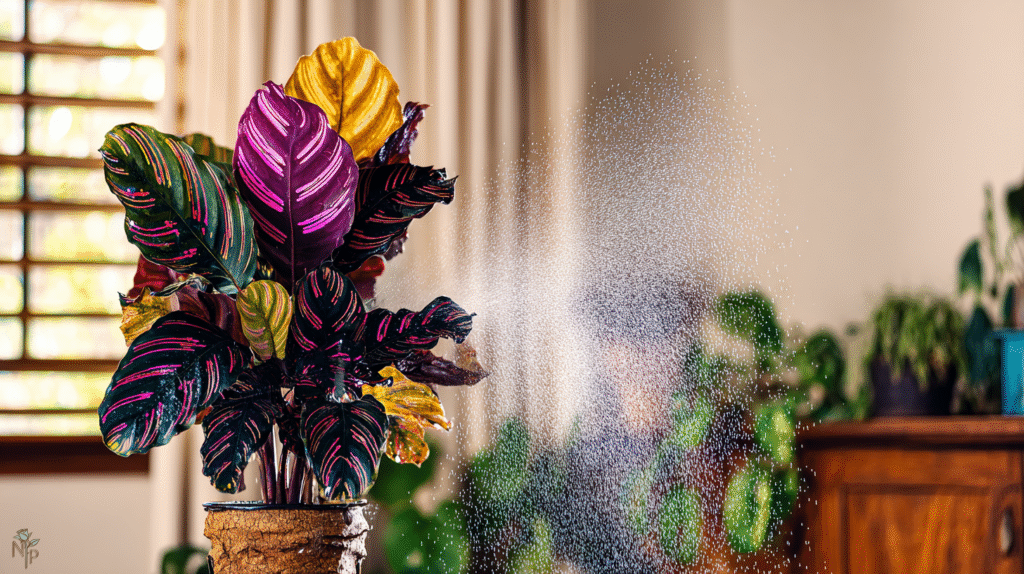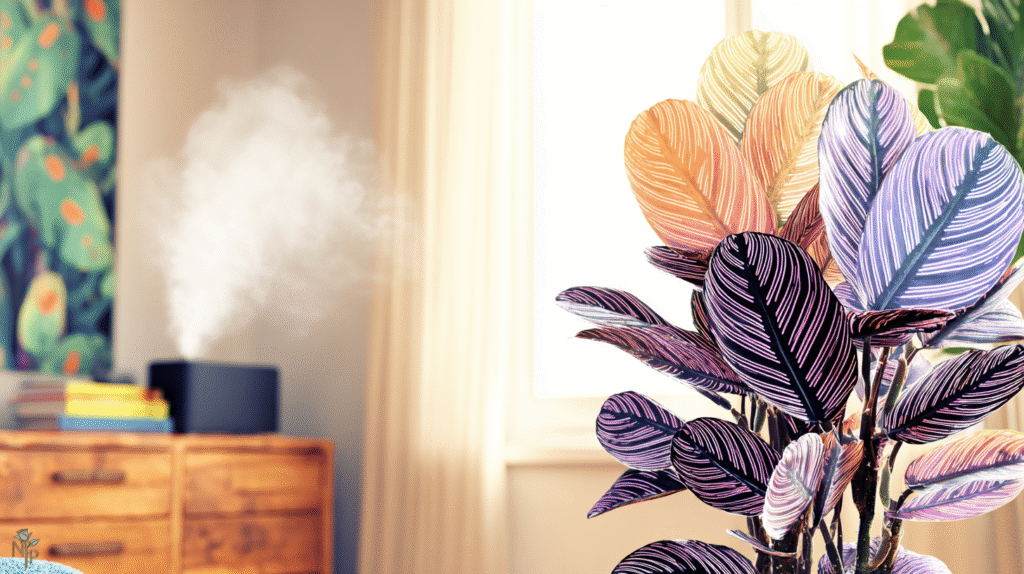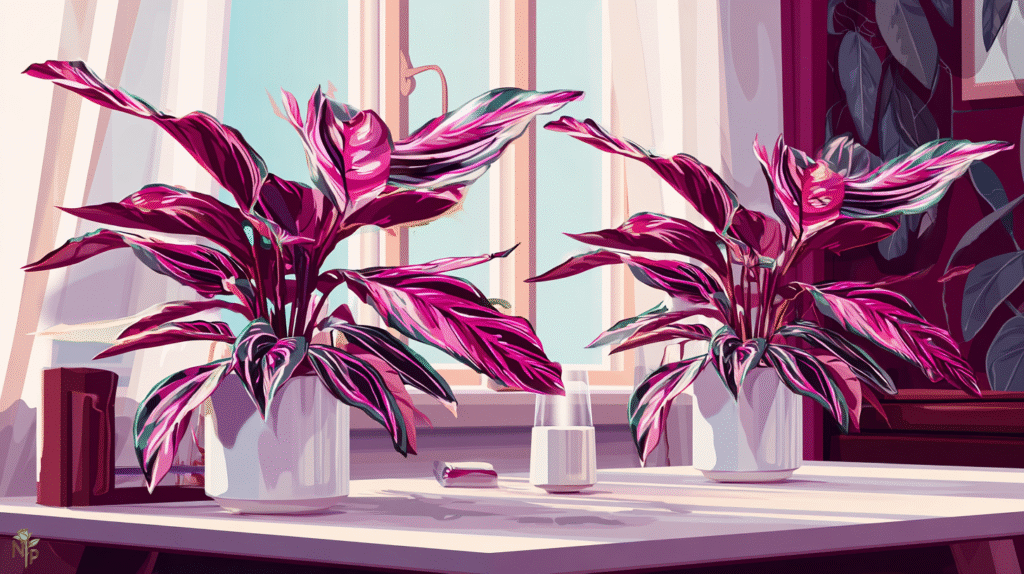The calathea at the plant shop stopped me in my tracks. Those leaves — painted with pink stripes, purple undersides, moving slightly in the breeze like they were alive. “That’s a prayer plant,” the clerk said. “Super easy!”
Narrator: It was not, in fact, super easy.
Within three weeks, my gorgeous calathea looked like someone had taken scissors to the edges. Brown, crispy borders on every single leaf. The pink stripes faded to sad beige. The prayer plant had apparently given up on praying and chosen death instead.
Three years and twelve calatheas later (yes, I have a problem), I finally understand these drama queens. They’re not difficult — they’re just incredibly specific about their needs. Miss one requirement and they’ll let you know immediately through interpretive leaf theater. Here’s everything I learned about keeping these beautiful divas happy.
Why Calatheas Are Different from Other Houseplants
Calatheas aren’t trying to be difficult. They’re rainforest floor plants pretending to live in your dry apartment. Understanding their natural habitat changed everything for me:
- Filtered light through tree canopy (not your “bright” living room)
- Constant 60-80% humidity (not your 30% winter air)
- Consistent temperatures day and night
- Rain water (not your chlorinated tap)
- Rich but well-draining forest floor soil
Basically, they want to live in a tropical spa while we’re offering them a desert prison. No wonder they’re cranky.
The Humidity Requirement That Changes Everything
This is the #1 calathea killer, and it murdered several of mine before I got it right. Your home’s humidity is probably 30-40%. Calatheas want 60% minimum. That gap is why your leaves get crispy.
What doesn’t work:
- Misting (lasts 5 minutes, can cause fungal issues)
- Pebble trays (maybe raises humidity 5%)
- Grouping plants (helps a little, not enough)
- Bathroom without humidifier (still too dry)
What actually works: Humidifier. Period. I resisted buying one for months, trying every hack. Finally spent $35 on a small humidifier. Game completely changed. Crispy edges stopped. Colors got vibrant. New growth exploded.
My calathea corner now has a humidifier running 8-10 hours daily, keeping humidity at 60-65%. Yes, it’s extra equipment. Yes, it’s worth it. The difference between struggling calatheas and thriving ones is literally this machine.

Water: The Goldilocks Nightmare
Calatheas want their soil like that perfect chocolate chip cookie — moist but not soggy, never dry, always just right. This pickiness caused half my problems.
Water quality matters:
- Tap water = brown leaf tips (fluoride/chlorine sensitivity)
- Hard water = mineral buildup
- Cold water = shock and sadness
- Solution: Filtered or distilled water at room temperature
I fought this requirement. “Distilled water for plants? Ridiculous!” Then I switched. Brown tips disappeared within a month on new growth. Sometimes they’re right about being picky.
The watering sweet spot:
- Check every 2-3 days
- Water when top inch is dry
- Never let it fully dry out
- Never let it stay soggy
- Bottom watering prevents dry pockets
My rattlesnake calathea taught me this balance. Too dry? Leaves curl inward. Too wet? Yellow leaves appear. Just right? Happy prayer plant movements every evening.
Light: Brighter Than You Think, But Not How You Think
“Low light plant” is the biggest calathea lie. They don’t want low light — they want bright shade. There’s a difference, and it took me forever to understand.
What murders calatheas:
- Dark corners (slow death by stretching)
- Direct sun (immediate crispy death)
- North windows only (not enough energy)
What makes them thrive:
- Few feet from east/west windows
- Bright room with no direct sun
- Under grow lights on timers
- Filtered south window light
My medallion calathea in the “bright” corner stayed alive but looked sad. Moved 3 feet from an east window? Transformed into a showpiece. They want to see the sky, not the sun.
Temperature: No Surprises, Please
Calatheas hate temperature drama. They want boring, consistent warmth.
Temperature needs:
- Day: 65-75°F ideal
- Night: No more than 10° drop
- Never below 60°F
- No drafts, period
Death zones in your house:
- Near AC vents (learned this hard way)
- By drafty windows
- Close to heating registers
- Near frequently opened doors
My white fusion calathea lived by the front door. Every winter opening shocked it with cold air. Moved to the stable-temperature living room center = no more random leaf crisping.
The Prayer Plant Movement That Freaked Me Out
Nobody warned me calatheas MOVE. The first night I heard rustling and thought I had bugs. Nope — just my calatheas doing their nightly prayer routine, folding leaves up like hands in prayer.
What the movement tells you:
- Strong movement = happy plant
- Minimal movement = stressed plant
- No movement = probably dying
- Extra dramatic movement = very happy
This movement (called nyctinasty) helps them capture moisture at night. Once I understood it was normal, I started using it as a health indicator. Vigorous evening movement? All is well. Weak movement? Time to investigate.
Soil: The Forest Floor Recreation
Standard potting soil holds too much water for calatheas. They want moisture-retentive but well-draining — another Goldilocks situation.
My calathea mix:
- 50% peat-based potting mix
- 25% perlite
- 20% orchid bark
- 5% charcoal
This mimics forest floor conditions — holds moisture without getting swampy. Since switching from regular potting soil, root rot problems disappeared.
Common Calathea Problems Solved
Crispy brown edges:
- Usually humidity too low
- Sometimes water quality
- Rarely overfertilizing
- Solution: Humidifier + filtered water
Yellowing leaves:
- Overwatering most common
- Sometimes old leaves naturally aging
- Check for root rot if widespread
- Solution: Adjust watering, check roots
Fading patterns/colors:
- Not enough light
- Move gradually to brighter spot
- Variegated types need more light
Curling leaves:
- Underwatering or low humidity
- Plant protecting itself
- Check soil moisture first
Spider mites:
- Love dry conditions
- Check undersides regularly
- Shower monthly as prevention
- Neem oil if infestation found
Different Calatheas, Different Attitudes
Easier varieties I recommend starting with:
- Rattlesnake plant: Most forgiving
- Network: Handles lower humidity better
- Medallion: Good communicator
Intermediate challenges:
- Ornata (pinstripe): Slightly fussier
- Makoyana (peacock): Moderate drama
- Zebrina: Humidity demanding
Advanced only:
- White Fusion: Humidity queen
- Musaica: Very specific needs
- Roseopicta varieties: Easy to upset
Start with rattlesnake. If you can keep it happy for six months, level up.
My Calathea Success Setup
After all the failures, here’s what works:
Location: Living room, 4 feet from east window Humidity: Humidifier maintaining 60-65% Water: Filtered, room temperature, when topsoil dry Temperature: Steady 68-72°F Soil: My forest floor mix Fertilizer: Quarter strength monthly in growing season
This setup transformed my calathea collection from crispy sadness to Instagram-worthy specimens. No more brown edges, vibrant patterns, and that satisfying evening prayer movement.

Why I Keep Growing These Demanding Plants
Yes, they’re fussy. Yes, they need equipment (humidifier). Yes, they’ll throw tantrums if you look at them wrong. But successfully growing calatheas is like solving a beautiful puzzle.
When that white fusion unfurls a perfect new leaf, when the rattlesnake’s patterns catch the light, when evening comes and they all fold up in prayer — it’s magic. They’re living art that interacts with their environment.
My collection started with one crispy disaster. Now I have twelve varieties creating a prayer plant corner that makes everyone ask, “How do you keep them so perfect?” The answer: I finally listened to what they were telling me they needed instead of what I thought they should need.
Your Calathea Success Plan
- Start with a rattlesnake plant (most forgiving)
- Get a humidifier immediately (non-negotiable)
- Use filtered water always
- Find bright indirect light spot
- Keep temperatures stable
- Check soil moisture every 2-3 days
- Don’t panic at leaf movement
Calatheas will test your patience initially. They’ll crisp, curl, and complain. But nail their specific needs and they become predictable, rewarding, and absolutely stunning. Just remember: they’re not being difficult — they’re being rainforest plants. Respect that, and they’ll thrive. 🍃







